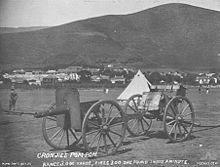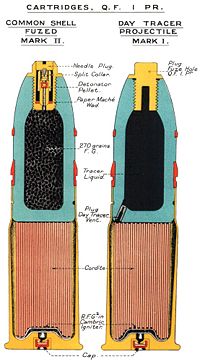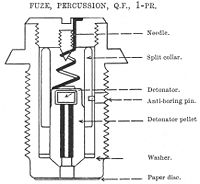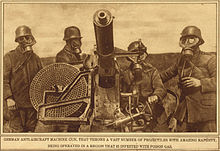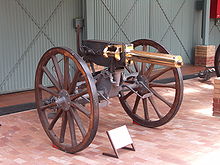- QF 1 pounder pom-pom
-
QF 1 pdr Mark I & II ("pom-pom") 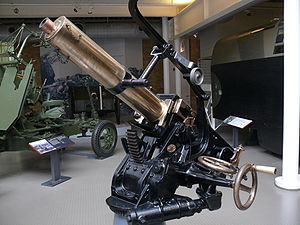
Mk II gun dated 1903, on anti-aircraft mounting, at the Imperial War Museum, LondonType Autocannon Place of origin  United Kingdom
United KingdomService history In service 1890s–1918 Used by  South African Republic
South African Republic
 British Empire
British Empire
 Germany
Germany
 Belgium
Belgium
 United States
United StatesWars Second Boer War
World War IProduction history Designer Hiram Maxim Designed 1890 Manufacturer Maxim-Nordenfelt
Vickers, Sons & Maxim
DWMVariants Mk I, Mk II Specifications Weight 410 pounds (186.0 kg) (gun & breech) Length 6 ft 1 in (1.85 m) (total) Barrel length 3 ft 7 in (1.09 m) (bore) Shell 37 x 94R. 1 lb (0.45 kg) Common Shell Calibre 37-millimetre (1.457 in) Barrels 1 Action automatic, recoil Muzzle velocity 1,204 ft/s (367 m/s)[1] Maximum range 4,500 yards (4,110 m) (Mk I+ on field carriage)[2] Filling weight 270 grains (17 g) black powder The QF 1 pounder, universally known as the pom-pom,[3][4] was an early 37 mm British autocannon. It was used by several countries initially as an infantry gun and later as a light anti-aircraft gun. The name comes from the sound it makes when firing.
Contents
History
Hiram Maxim originally designed the Pom-Pom in the late 1880s as an enlarged version of the Maxim machine gun. Its longer range necessitated exploding projectiles to judge range, which in turn dictated a shell weight of at least 400 grams (0.88 lb), as that was the lightest exploding shell allowed under the St. Petersburg Declaration of 1868 and reaffirmed in the Hague Convention of 1899.[5]
Early versions were sold under the Maxim-Nordenfelt label, whereas versions in British service (i.e. from 1900) were labelled Vickers, Sons and Maxim (VSM) as Vickers had bought out Maxim-Nordenfelt in 1897. They are all effectively the same gun.
British service
Second Boer War
The British government initially rejected the gun but other countries bought it, including the South African Republic (Transvaal) government. In the Second Boer War, the British found themselves being fired on with success by the Boers with their 37 mm Maxim-Nordenfelt versions with ammunition made in Germany.
In response, Vickers-Maxim of Britain shipped either 57 or 50[6] guns out to the British Army in South Africa, with the first three arriving in time for the Battle of Paardeberg of February 1900.[7] These early Mk I versions were mounted on typical field gun type carriages.
World War I
In World War I, it was used as an early anti-aircraft gun in the home defence of Britain. It was adapted as the Mk I*** and Mk II on high-angle pedestal mountings and deployed along London docks and on rooftops on key buildings in London, others on mobile motor lorries at key towns in the East and Southeast of England. 25 were employed in August 1914, and 50 in February 1916.[8] The Mk II gun at the top of this page on Naval pedestal mounting was the first to open fire in defence of London during the war.[2] However, the small shell was insufficient to damage the German Zeppelin airships sufficiently to bring them down.[9] The Ministry of Munitions noted in 1922: "The pom-poms were of very little value. There was no shrapnel available for them, and the shell provided for them would not burst on aeroplane fabric but fell back to earth as solid projectiles... were of no use except at a much lower elevation than a Zeppelin attacking London was likely to keep".[10]
Nevertheless, Lieutenant O.F.J. Hogg of No. 2 AA Section in III Corps was the first anti-aircraft gunner to shoot down an aircraft, with 75 rounds on 23 September 1914 in France.[11]
The British Army did not employ it as an infantry weapon in World War I, as its shell was considered too small for use against any objects or fortifications and British doctrine relied on shrapnel fired by QF 13 pounder and 18-pounder field guns as its primary medium range anti-personnel weapon.
The gun was tried with only limited success mounted on aircraft as the lighter 1-pounder Mk III, and was quickly replaced by the larger QF 1½ pounder and QF 2 pounder naval guns as a light anti-aircraft gun.
British Ammunition
The British are reported to have initially used some Common pointed shells (semi-armour piercing, with fuze in the shell base) in the Boer War, in addition to the standard Common shell. However, the common pointed shell proved unsatisfactory, with the base fuze frequently working loose and falling out during flight.[7] In 1914, the cast-iron common shell and tracer were the only available rounds.[12]
Mk II explosive Common shell & Mk I tracer round Mk I nose percussion fuze German service
A version was produced in Germany for both Navy and Army.[2]
In World War I, it was used in Europe as an anti-aircraft gun as the Maxim Flak M14. Four guns were used mounted on field carriages in the German campaign in South West Africa in 1915, against South African forces.[13]
Belgian service
The Belgian Army used the gun on a high-angle field carriage mounting.[2]
United States service


On USS Vixen, circa. 1898–1901 The U.S. Navy adopted the Maxim-Nordenfelt 37 mm 1 pounder as the 1-pounder Mark 6 before the 1898 Spanish–American War.[14]
Surviving examples
- A gun from 1903 at the Imperial War Museum London[15]
- Two German-manufactured 1903 guns used during World War I are on display at the South African National Museum of Military History, Johannesburg. Nr. 542 and 543 from the Deutsche Waffen und Munitions Fabriken
- A German-manufactured gun in the Wehrtechnische Studiensammlung Koblenz[16]
- A gun in the Canadian War Museum.
- A gun in the Museo Naval y Maritimo Valparaiso, Chile[17].
See also
- COW 37 mm gun
- List of anti-aircraft guns
- List of infantry guns
- British standard ordnance weights and measurements
Notes and references
- ^ Tony DiGiulian, Britain 1-pdr (0.45 kg) 1.46" (37 mm) Mark 1
- ^ a b c d Hogg & Thurston 1972, pp. 22–23
- ^ "Weapons". Australian Boer War Memorial Committee. http://www.bwm.org.au/site/Weapons.asp. Retrieved 2008-08-28.
- ^ "...my paper strength will be 2,400 mounted men, 6 guns, and 8 pom-poms". Brigadier Henry Rawlinson, 2 January 1902, in South Africa. From "The Life of General Lord Rawlinson of Trent", by Sir Frederick Maurice. London: Cassell, 1928
- ^ Hogg & Thurston 1972, p. 22, state the Hague Convention dictated the 1 lb (0.45 kg) shell; however 400 grams was set as the minimum for exploding shells by Laws of War: Declaration of St. Petersburg; November 29 1868
- ^ ‘The Times History of the War in South Africa’ mentions 57; Headlam ‘The History of the Royal Artillery’ only mentions 50.
- ^ a b Fiona Barbour, The South African Military History Society Military History Journal - Vol 3 No 1 June 1974. Mystery Shell
- ^ Farndale 1988, pp. 362–363
- ^ Routledge 1994, p. 7–8
- ^ Official History of the Ministry of Munitions 1922, Volume X, Part 6, pp. 24–25. Facsimile reprint by Imperial War Museum and Naval & Military Press 2008. ISBN 1 847348 84 X
- ^ Routledge 1994, p. 5
- ^ Treatise on Ammunition 10th Edition, 1915. War Office, UK
- ^ Major D.D. Hall, The South African Military History Society Military History Journal - Vol 3 No 2, December 1974. "GERMAN GUNS OF WORLD WAR I IN SOUTH AFRICA". Major Hall states that these guns were made by Krupp, but the 2 captured guns in the South African Military History Museum were made by Deutsche Waffen und Munitionsfabriken (DWM)
- ^ Tony DiGiulian, United States of America 1-pdr (0.45 kg) 1.46" (37 mm) Marks 1 through 15
- ^ http://london.iwm.org.uk
- ^ http://www.bwb.org:80/portal/a/bwb/!ut/p/c4/04_SB8K8xLLM9MSSzPy8xBz9CP3I5EyrpHK9pPIkvdLUpNSi0jy9lMRiELc8NaOoJDVZvyDbUREA-WplZw!!/
- ^ http://www.museonaval.cl
Bibliography
- General Sir Martin Farndale, History of the Royal Regiment of Artillery. The Forgotten Fronts and the Home Base, 1914–18. London: Royal Artillery Institution, 1988. ISBN 1 870114 05 1
- I.V. Hogg & L.F. Thurston, British Artillery Weapons & Ammunition 1914–1918. London: Ian Allan, 1972. ISBN 9780711003811
- Brigadier N.W. Routledge, History of the Royal Regiment of Artillery. Anti-Aircraft Artillery, 1914–55. London: Brassey's, 1994. ISBN 1 85753 099 3
External links
- Anthony G Williams, 37MM AND 40MM GUNS IN BRITISH SERVICE
Categories:- 37 mm artillery
- Automatic cannons
- World War I artillery of the United Kingdom
- Anti-aircraft guns of Germany
- World War I anti-aircraft guns
- Second Boer War artillery
- Vickers
Wikimedia Foundation. 2010.


